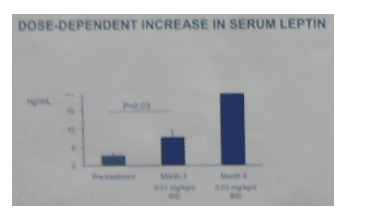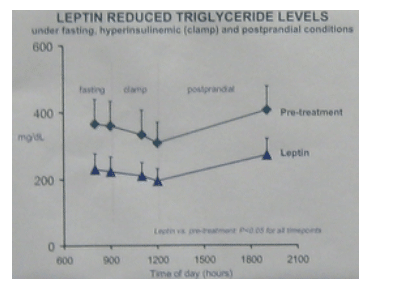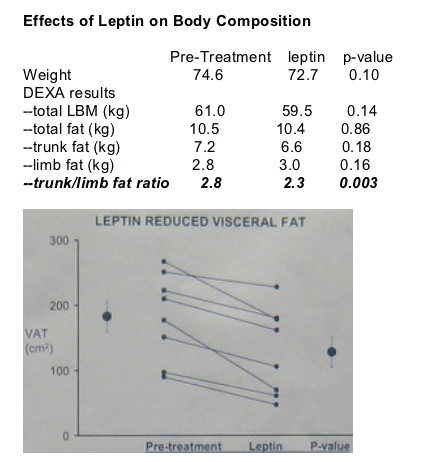 |
 |
 |
| |
Leptin Reduced VAT by 30%/Improved Metabolics in Pilot Study
|
| |
| |
Reported by Jules Levin
CROI, Feb 2007, Los Angeles
"Improvements in Hepatic and Adipocyte Insulin Sensitivity, Dyslipidemia, and Visceral Fat during Leptin Treatment in HIV-infected Men with Lipoatrophy and Hypoleptinemia"
Kathleen Mulligan*1, H Khatami1, J M Schwarz1,2, J M Schwarz1,2, G Sakkas1, A DePaoli3, G Lee1, V Tai1, M Wen1, C Grunfeld1, and M Schambelan1
1Univ of California, San Francisco, US; 2Touro Univ, Vallejo, CA, US; and 3Amgen, Inc, Thousand Oaks, CA, US
The authors concluded, leptin treatment was associated with marked improvement in dyslipidemia (VAT decreased by 30%) in a group of patients already treated with lipid-lowering agents. Visceral fat decreased with no exacerbation of peripheral lipoatrophy. Hepatic insulin sensitivity improved and lipolysis decreased. Results from this pilot study suggest that leptin may have therapeutic potential in HIV-infected patients with metabolic and morphologic alterations.
Background: Leptin treatment improves lipid and glucose metabolism in non-HIV lipodystrophy. The present study was designed to determine whether leptin could produce similar benefits in HIV-infected patients with lipoatrophy.
Methods: In this open-label, proof-of-principle study, 8 HIV± men with lipoatrophy (with or without fat accumulation), hypoleptinemia (<3 ng/mL), dyslipidemia (despite use of lipid lowering agents in 7 of 8), and insulin resistance, received recombinant human leptin for 6 months (0.01 mg/kg twice daily for 3 months, followed by 0.03 mg/kg twice daily for 3 months). Glucose and lipid metabolism was assessed under fasting conditions and during a euglycemic, hyperinsulinemic clamp with stable isotope infusions before and after 6 months of treatment. Visceral and subcutaneous abdominal fat (at L4-L5) were measured by magnetic resonance imaging and peripheral fat by DEXA. Data are mean ±SE. Results were analyzed by paired t-test.
Results:
There was a dose dependent increase in leptin levels in patients.

There were significant decreases in fasting levels of total from 224 (196-252) to 200 (168-214) mg/dL, p = 0.02), direct LDL (138 (130-153) to 115 (102-121) mg/dL, p = 0.008), and non-HDL from 198 (182-220) to 178 (137-184) mg/dL, p = 0.02) cholesterol. HDL cholesterol tended to increase from 24 (20-30) to 27 (24-35) mg/dL, p = 0.055). Triglyceride levels decreased significantly under fasting, hyperinsulinemic (clamp), and postprandial conditions.

Whole-body lipolysis and free fatty acid levels decreased significantly during both fasting and hyperinsulinemia.
Fasting glucose did not improve (106 before Leptin, 104 after Leptin. HOMA IR was 5.6 before & 4.1 after Leptin (p=0.05). Fasting insulin (21±3 to 16±2 mIU/mL, p = 0.04), endogenous glucose production (2.8±0.1 to 2.5±0.1 mg/kg/minutes, p = 0.005), and glycogenolysis (2.2±0.1 to 1.9±0.1 mg/kg/minutes, p = 0.03) decreased significantly, as did glucose production, glycogenolysis, and gluconeogenesis measured during the clamp, providing evidence of improvements in hepatic insulin sensitivity. Peripheral glucose uptake (clamp) improved modestly but the increase was not statistically significant.
Visceral abdominal fat decreased by 30% (183±24 to 129±24 cm2, p = 0.001) with no significant changes in subcutaneous or peripheral fat, suggesting that leptin may have a depot-specific effect on adopise tissue. Leptin was 'exceptionally' well tolerated: no serious adverse events, no significant changes in AST/ALT, alkaline phosphotase, BUN & crestinine stable, no significant change in Hgb, WBC, Hct, CD4 & CD8 stable.
VAT was 183 before leprin and 129 cm2 after leptin (p=0.001).
SAT was 101 before & 90 after leptin (p=0.45).

|
| |
|
 |
 |
|
|